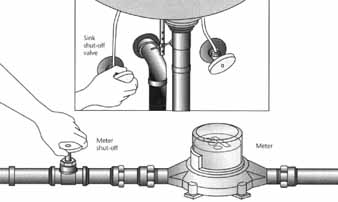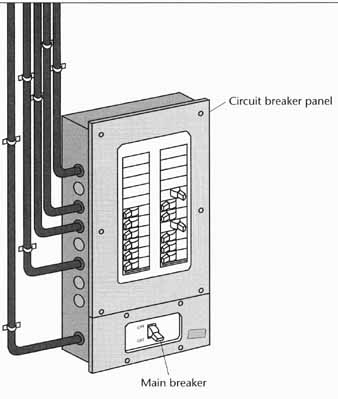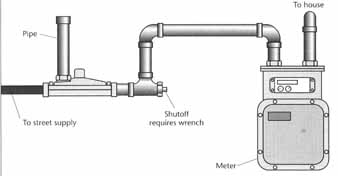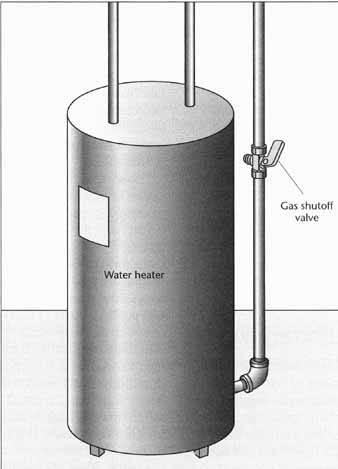The ultimate threat involving water dam age to your house is a flood. During the extreme weather of the past few years, much of the United States has been subjected to record flooding; the danger of flooding is exacerbated if the house is near a stream, river, or drainage pond. But even in cities, low-lying areas may be subject to flooding by storm-of-the century downpours. When buying a house, check with local realtors or building inspectors to learn if the area where you will live is subject to flooding.
Aside from investigating the flood history of an area to avoid buying a house that sits on a flood plain, there is little you can do to avoid floods. When a flood threatens, have an evacuation plan to ensure family safety and try to limit damage to the house and its contents.
FLOOD INSURANCE
Before you experience a flood, check with your insurance agent to learn the limits of your home insurance policy. Coverage for flood damage may require a special amendment to your insurance policy, or a separate policy. Be sure your policy is up to date: inflation has driven the cost of replacement for house and furnishings to ever-higher levels, and the increased ownership of expensive electronic gear has also inflated the value of the contents of the home. If your entire wardrobe is lost, the cost of replacement may be shockingly prohibitive. Be sure your insurance coverage reflects the actual replacement value of your possessions.
Most household policies limit the coverage for expensive items such as art, cameras, jewelry, and furs. If you own any such valuables, have your insurance agent attach a rider to your policy for extended coverage. Keep all the receipts for any major purchases, and have expensive items appraised. You may be surprised to learn that luxuries bought many years ago have vastly increased in value.
Finally, make an inventory of every item of personal property. First make a written, room-by-room inventory, along with receipts for the room con tents. Then use a still or video camera to do a photo inventory of every room. Be sure that anything of value is visible in the photo or video tape: open closet doors and photograph the contents of the closet. Do this for every room in the house, then store the written inventory and photos or video tape in a safe place outside the house, such as in a safety deposit box, so it can't be lost in a storm or flood.
SHUT-OFF UTILITIES
If predicted flooding will be severe enough that evacuation from the house is necessary, take steps to limit water damage to the house. Shut off the main water valve. This is the gate valve located near the water meter, on the street side of the meter. If you have a well, shut off the valve located either near the water tank or on the supply pipe from the well to the house. This pre vents flood water from contaminating your water supply.
To avoid electrical fires or dangerous shocks to family members when you return to the house, pull the main fuse at the fuse box or the main entry panel, or switch off the main circuit breaker. This will shut down all the electrical circuits in the house.
On gas appliances, including the furnace, shut off all standing pilot lights, and shut off the gas main at the meter. Hang a wrench above the meter so it's handy for emergency shut off. For safety, don’t turn the gas on or replace the main fuse in the electrical panel until the systems have been inspected by the utility companies. Better yet, have the utilities turned back on by qualified service- people, after they have conducted professional inspections.

Water Supply: Shut off water at the meter.
REMOVE FURNITURE
Your first concern should always be family safety, so don’t jeopardize human safety to protect property. If time permits, move your most valuable furniture, small appliances, and personal items to an upper floor. If there is no upper floor, stack the most expensive items on tables or on the highest shelves, to try to keep them above the water. For large appliances that can not be moved, such as the electric range or refrigerator, disconnect the power plugs.
EMERGENCY KITS
If you live in an area that's subject to frequent storms or flooding, don’t wait until an emergency has begun to consider emergency equipment. Assemble an emergency kit that contains vital items and can be kept in the car. Items included in the kit may vary depending on the type of storm you expect. A general purpose emergency kit should con tam a portable radio and extra batteries, a flashlight, blankets or sleeping bags, jumper cables to start the car, candles and matches in a watertight can (to be used for either light or heat), a shovel, and a road map. Also include a first aid kit, along with any prescription medicines needed by family members.
Listen to weather updates and move to higher ground well ahead of the flood; don’t delay until water covers and conceals the pathway to safety. Don’t try to wade or drive through water where you can't see the bottom; raging water can wash out roadbeds, so the water may be deeper than you think and currents can wash you or your vehicle away. Head for high ground while you can still see the roadway. Insert “Cleaning Flood-Damaged Interior”.
(Put together your own Emergency Plumbing Kit)

Electric Service Panel: Shut off electricity at the
service panel. Shown here is a main circuit breaker shutoff; this may
vary. Learn how to shut off your service before an emergency occurs.
CLEANING FLOOD-DAMAGED INTERIORS
Entering a flood-damaged house can be a shocking experience; the damage done by water to the house interior and furnishings appears at first sight to be devastating. But, by taking prompt action, the flood damage can be limited.
The first step is to remove all the contents of the house. Store them in the garage, and leave the garage door open for air circulation. If you have no garage, rent storage space. Next, pull up all rugs or carpets and remove them to the outdoors (water that has penetrated under vinyl floors or soaked into carpets will rapidly deteriorate the carpets and will cause the floors or underlayment to decay). If the carpets or rugs are allowed to dry, and are cleaned, they may be salvageable.
Power-washing the walls and floors of a flooded house is the most effective way to remove mud and dirt.
To clean dirty walls or ceilings, mix 5 tablespoons (75 milliliters) of tri-sodium phosphate (available at paint stores) with 1 cup (250 milliliters) of bleach into a gallon (4 liters) of warm water. Use a sponge or sponge mop to wash the soiled surfaces, then rinse with clean water. Allow the walls to dry completely before repainting.
After cleaning, the only way to remove so much moisture from the house is by utilizing moisture transfer between the humid indoor air and the dry outside air. Open the windows or remove window sashes to allow fresh air to circulate throughout the house. To maximize air flow, remove storm windows or window screens, and operate portable fans or dehumidifiers. The best way to force air flow is to open all windows and doors, then set fans facing outward near doors or windows on one side of the house. This procedure provides cross ventilation by pulling air into the house through windows on one side of the house and exhausting it through windows on the opposite side.
If exposed for a pro longed period to standing water, wallboard and plaster can be destroyed. If flood waters recede quickly, and the house is allowed to dry out, these wall and ceiling materials often will be relatively undamaged. Let the surfaces dry completely before you attempt to assess the damage. When the wallboard or plaster is completely dry, push against it with the palm of your hand. If the wallboard or plaster feels soft or spongy under hand pressure, replacement may be necessary. In most cases, ceilings and walls will need minor touch-ups and repairs.
Take apart all locks and hinges on doors or windows. Clean them thoroughly, then apply a light coating of a lubricant such as WD-40 to all moving parts.
Don’t be in a hurry to redecorate. New paint may lock residual moisture in the wall or ceiling cavities, causing development of mold, odors, or mildew. The drying time depends on both the extent of the damage and the climate in which you live. Depending on the seasonal humidity, a drying period of six months may be required before the interior is dry and is ready for redecoration.

Gas Supply: To shut down the gas supply to the entire
house in an emergency, hang a wrench near the gas shutoff.

Gas Appliance Valve: A gas service shutoff valve is
located near all gas appliances so that the appliance can be serviced
without shutting down the entire house. If a flood is imminent, shut
off the main supply at the meter.
CLEANING FLOOD-DAMAGED APPLIANCES
When you return to a house that has been damaged by a flood, don't try to restore electric power yourself. Have the electrical system and appliances inspected by a qualified service person. Switches and other electrical devices that have been flooded can be wet and can short out or inflict a painful or dangerous shock to family members. Have the service person turn the power on after a complete inspection and when the service has been approved for use.
With the power main shut off, remove, disassemble, and clean light fixtures and lamps before using them. Water can enter cracks in power cords, so replace the power cords on floor or table lamps.
Major appliances such as refrigerators and freezers have sealed motors and may survive flooding. However, you should have their electrical components, such as thermostats and relays, checked by an electrician. If the water has penetrated the insulation in the refrigerator, lingering odors may make it necessary to replace the appliance. To repair other appliances or tools with electric motors, such as saws, blenders, or food processors, remove the motors and take them to an appliance repair shop for cleaning and service.
CLEANING FLOOD-DAMAGED FURNITURE
Because of the absorbent padding or fill in mattresses, upholstered furniture, and pillows, it's difficult to remove moisture, odors, or bacteria from these furnishings. In most cases these items must be discarded after a flood.
Furniture made of manufactured wood such as plywood or particle board will likely deteriorate and be permanently damaged by water exposure. However, if handled properly, most solid wood furniture can be salvaged. Home insurance policies don't cover flood damage. Check with your agent before you have a loss. You may be able to buy a flood insurance policy available through the government in the U.S.
To salvage solid wood furniture, first use warm water, a detergent, and a scrub brush to remove any mud or dirt. Next, use Borax dissolved in hot water to remove any mold from the furniture, following the directions on the Borax box for the proper mix proportion. Remove the doors and drawers from furniture such as dressers or cabinets, and arrange them so that there is space between them to permit full air circulation to dry the wood. A good approach is to place the doors and drawers so they lie flat and rest on sawhorses, so air can circulate around all sides.
Never move wood furniture into sunlight to dry, because the direct heat of the sun may dry the wood too quickly and cause it to warp, twist, or crack. Dry the furniture indoors, with windows and doors open for cross ventilation. Running a dehumidifier will help dry the wood.
If white water spots or film develop on the wood finish, mix ½ cup (125 milliliters) of warm water with ½ cup (125 milliliters) of household ammonia. Soak a clean cloth in the ammonia/water solution and wipe it over the white areas. Repeat if necessary until the white spots are gone. Allow the furniture to dry completely.
Do not be in a hurry to wax the wood. Allow the wood to dry completely, then use 4/0 (fine) steel wool to apply a liquid wax/polish. When the wax has dried, buff the furniture with a soft dry cloth.
DRINKING WATER
Floods or major storms may interrupt or contaminate the drinking water supply. There may be potable water in the water heater or the toilet tank if they have not been submerged in flood water. If flood water has not entered the freezer, you can melt ice cubes to get water for drinking or cooking.
If no drinking water is available, you can boil water to purify it. To purify the water, bring it to a rolling boil for five minutes. Let the water cool, then pour it rap idly back and forth between two containers. This will aerate the water, help remove odors, and improve the taste of the water.
You can buy water purification tablets at most drug or camping supply stores. If you have no purification tablets, use plain bleach (containing no detergents or additives) to purify the water. Four drops of bleach will purify 1 quart (1 liter) of water; ¼ teaspoon (1 milliliters) will purify 1 gallon (4 liters), and 1 teaspoon (5 milliliters) of bleach will purify 5 gallons (20 liters) of water. Mix the bleach/water solution completely and let it stand for 30 minutes before drinking the water to be sure all bacteria are killed.